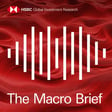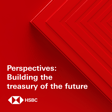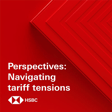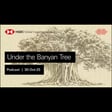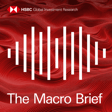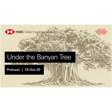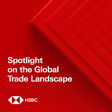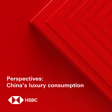Become a Creator today!Start creating today - Share your story with the world!
Start for free
00:00:00
00:00:01

The Macro Brief - China’s recovery, the Fed's outlook, dollar drivers
Jing Liu looks at how policymakers can boost confidence in China's recovery, Ryan Wang explains why the US rate hiking cycle is not yet over and Dominic Bunning outlines a framework for thinking about the dollar. Disclaimer: https://www.research.hsbc.com/R/51/xjClbgq Stay connected and access free to view reports and videos from HSBC Global Research follow us on LinkedIn https://www.linkedin.com/feed/hashtag/hsbcresearch/ or click here: https://www.gbm.hsbc.com/insights/global-research.
Hosted on Acast. See acast.com/privacy for more information.
Transcript
Introduction and Disclaimers
00:00:00
Speaker
The following podcast was recorded on the 8th of June by HSBC Global Research.
00:00:04
Speaker
All the disclosures and disclaimers associated with it must be viewed on a link attached to your media player.
00:00:08
Speaker
You can find us on Apple and Spotify, or wherever you get your podcasts, by searching for The Macro Brief.
00:00:14
Speaker
And don't forget to give us a rating.
00:00:16
Speaker
Now, on to the podcast.
Host Introductions and Podcast Overview
00:00:19
Speaker
Hello, I'm P.S.
00:00:20
Speaker
Butler in London.
00:00:21
Speaker
And I'm Aline Van Dyne in New York.
00:00:24
Speaker
Here's what's coming up this week.
China's Economic Momentum: Current Challenges
00:00:26
Speaker
China's economic momentum is slowing.
00:00:28
Speaker
So is this it for the recovery?
00:00:30
Speaker
We find out why there might not be any quick fixes.
00:00:33
Speaker
We look at how the latest economic data have clouded the monetary policy outlook in the U.S. And we take a step back to look at some of the big picture drivers of the U.S. dollar.
00:00:47
Speaker
China's recovery has been one of the themes dominating economic debate this year.
00:00:51
Speaker
But some of the latest data releases have been weaker than expected, leaving investors wondering how much further the recovery has to go.
00:00:59
Speaker
So how will policymakers respond?
00:01:02
Speaker
Jing Liu is our chief economist for Greater China.
00:01:05
Speaker
She spoke to Gray Mackay earlier.
00:01:08
Speaker
Jing, welcome to the podcast.
00:01:09
Speaker
Thanks for having me.
00:01:11
Speaker
So let's start with the title of this latest piece on China's recovery, Beyond a Quick Fix.
Is China's Recovery Losing Steam?
00:01:16
Speaker
How big a fix is needed?
00:01:19
Speaker
In this piece, we're trying to answer two key questions on investors' mind.
00:01:23
Speaker
The first one is, is China's recovery losing steam?
00:01:27
Speaker
The second one is, given the data has disappointed, will Beijing do anything about it?
00:01:34
Speaker
Okay, let's take those questions one by one, starting with is the recovery starting to run out of steam?
00:01:40
Speaker
I mean, I think at this point, consensus is that the answer is pretty much yes, is it not?
00:01:44
Speaker
Well, I would say actually it's more nuanced than that.
00:01:47
Speaker
Probably people have very high expectation from the beginning of the year and also expect Beijing to come in and use the old toolbox to stimulate the economy.
Service Sector Performance and Economic Impact
00:02:00
Speaker
But the reality tends to be this is more an organic growth in the sense that we will see
00:02:07
Speaker
imbalances and certain sectors such as service consumption outperforms.
00:02:13
Speaker
Others might take slightly longer time.
00:02:16
Speaker
Is there any industry in particular that you're looking to gather steam to really support the recovery that maybe hasn't quite gathered that momentum just yet?
00:02:24
Speaker
Well, for the consumption, for example, we see the service sector booming first, and that will bring back jobs, that has brought back jobs already.
00:02:35
Speaker
And then, you know, when there's a steady income, steady outlook for job market, we will see people start buying on the goods as well.
Beijing's Potential Stimulus Measures
00:02:46
Speaker
Now, part two of your report looks into the question of will Beijing roll out significant stimulus to maybe shore up the recovery and maximize its potential.
00:02:56
Speaker
Now, we've seen this historically in China on a number of occasions, I suppose most notably during the financial crisis, that 4 trillion RMB stimulus package.
00:03:05
Speaker
But that was quite a long time ago.
00:03:07
Speaker
Things aren't necessarily the same anymore.
00:03:09
Speaker
And what are your thoughts on a potential offering from Beijing in that regard?
00:03:14
Speaker
Indeed.
00:03:15
Speaker
Actually, some people are quite disappointed because they thought Beijing should have come out and roll out the stimulus plan already.
00:03:25
Speaker
But in reality, it seems like policymakers are much more patient this time around.
00:03:31
Speaker
It's not that they don't care.
00:03:34
Speaker
We believe they still have the pro-growth mentality.
00:03:38
Speaker
The reality is that they need to basically balance a short-term recovery with some longer-term challenges.
00:03:44
Speaker
In particular, they don't want the stimulus plan to contribute to the structural imbalances.
00:03:52
Speaker
What sort of structural imbalance would they be risking potentially?
Structural Imbalances and Public Investment
00:03:56
Speaker
So for example, in the past, we're very familiar with the recipe, the investment-led kind of growth, for example, infrastructure investment, housing investment, and probably large liquidity injection by PBOC as well.
00:04:13
Speaker
This time around, it looks like when they evaluate which policy might be the best they need to
00:04:20
Speaker
calculate the cost and benefit.
00:04:22
Speaker
For example, if they roll out a lot of public investment in infrastructure, will that crowd in or crowd out the private investment?
00:04:31
Speaker
And to what extent there's still enough room for local governments, for example, to actually contribute to the construction of infrastructure investment, etc.
00:04:42
Speaker
Do you think that there is a definitive answer to the question of will Beijing step in to stimulate the economy at this time?
Upcoming Political Events and Policy Direction
00:04:50
Speaker
I think the answer is yes, they will do it more proactively if there's, you know, a concern about financial stability.
00:05:03
Speaker
Otherwise, they will be more patient and the measure they will roll out tend to be more structurally oriented, like supporting the strategically important sectors, etc.
00:05:14
Speaker
Alright, and what about looking ahead, Jing?
00:05:15
Speaker
Any key events that we should be thinking about that may give us a flavor of policy direction in the future?
00:05:22
Speaker
Yes, indeed.
00:05:24
Speaker
The end of July, we should have the Politburo meeting.
00:05:28
Speaker
This one usually will focus on economic policy, so it probably will give a blueprint with respect to the big direction of the policies.
00:05:38
Speaker
And then the third plenum and the National Finance World Conference,
00:05:45
Speaker
We should probably see it end of third quarter, beginning of fourth quarter.
00:05:50
Speaker
That could give us, you know, more clear guidance on economic policies and, you know, the complementary financial policies to be expected in the following years.
00:06:04
Speaker
All right.
00:06:04
Speaker
Well, we'll be sure to keep a lookout for those events and any guidance that comes out along with them.
00:06:09
Speaker
Jing, thank you very much, as always.
00:06:10
Speaker
Yeah, thank you.
00:06:15
Speaker
Now, from one economic powerhouse to another.
US Monetary Policy: Post-Debt Ceiling Focus Shift
00:06:17
Speaker
The US debt ceiling may have been resolved, but attention is now turning to monetary policy.
00:06:22
Speaker
Aline, what's the story?
00:06:24
Speaker
That's right, Pierce.
00:06:25
Speaker
The Federal Reserve is set to meet next week, and the latest employment data have made the picture more complicated.
00:06:32
Speaker
Ryan Wang, our U.S. economist, is here to explain.
00:06:36
Speaker
Ryan, thanks for joining us.
00:06:37
Speaker
Hi, Eileen.
00:06:39
Speaker
What are you expecting at next week's FOMC meeting?
Fed's Rate Hike Pause and Future Projections
00:06:43
Speaker
Well, we made an adjustment, a slight adjustment, to our forecast for the policy rate.
00:06:48
Speaker
We expect the FOMC to leave the federal funds rate unchanged in June, and
00:06:52
Speaker
to skip a meeting, if you like, with respect to rate hikes.
00:06:56
Speaker
But we now expect that the FOMC's final 25 base point rate hike for this cycle will be delivered at the July FOMC meeting.
00:07:06
Speaker
So in some sense, what is happening is that the Fed is still focused on controlling inflation and bringing it lower.
00:07:13
Speaker
But at the same time, given the rapid rise in rates over the past year, the policymakers are taking more time between these decisions.
00:07:22
Speaker
and they're stretching out the rate hike process, you might say.
00:07:25
Speaker
So Ryan, what is the inflation picture looking like?
00:07:29
Speaker
And also, what about the jobs markets?
00:07:32
Speaker
Because the tightness there has obviously been a concern too.
Inflation Control and Job Market Challenges
00:07:36
Speaker
Well, really, if you look at the data that's come through this year, there's been a notable lack of downward progress, particularly on core PCE inflation.
00:07:45
Speaker
This is a measure that the FOMC tracks very closely.
00:07:48
Speaker
The core PC inflation rate actually edged up a bit to 4.7% in April.
00:07:54
Speaker
And that is well above the Fed's most recent forecast.
00:07:59
Speaker
that core piece inflation would fall to 3.6% by the end of this year.
00:08:04
Speaker
If you take this into account along with what's happening in the labor market, where there has been some anecdotal evidence that the job market may be becoming a little bit less tight, but overall there's still some difficulties for businesses in attracting and retaining workers.
00:08:20
Speaker
Well, it just means that the feds battle against inflation
00:08:25
Speaker
is not yet complete.
00:08:27
Speaker
And that's why the Fed may still have to consider rate hikes later this year.
00:08:32
Speaker
So you're painting a relatively hawkish outlook there.
00:08:36
Speaker
What are some of the other key risks or factors that play into this?
Banking Sector Stress and FOMC Decisions
00:08:41
Speaker
Well, that's right.
00:08:42
Speaker
I think the FOMC is carefully weighing the risks of persistently high inflation against the potential downside risks.
00:08:49
Speaker
Now, these relate to a few different areas.
00:08:52
Speaker
Of course, we have the banking sector stresses that have intensified since March.
00:08:58
Speaker
That's also having an impact on credit standards, which are being tightened for both businesses and households.
00:09:03
Speaker
And also there's risks related in particular to the commercial real estate sector.
00:09:08
Speaker
And so part of the idea of potentially skipping the June meeting is to take more time to assess these risks and to see how the data is evolving both on the macroeconomic side and also in terms of what's going on in the financial sector.
00:09:25
Speaker
So we actually expect the outcome at the June FOMC meeting to be a compromise.
00:09:29
Speaker
No change in the federal funds rate, but an emphasis that future rate hikes have not been ruled out.
00:09:35
Speaker
We expect to see that both in terms of the committee's projections and also in terms of the tone at Fed Chair Jerome Powell's press conference.
00:09:44
Speaker
Ryan, thank you so much for the update.
00:09:46
Speaker
Thanks, Aline.
Currency Markets Post-Debt Ceiling Resolution
00:09:51
Speaker
We stick to the US theme now, but switch to currency markets.
00:09:54
Speaker
And as the dust settles on the debt ceiling drama, Dominic Bunning, head of European FX Research, has been looking at which forces are likely to influence the green bank's path.
00:10:03
Speaker
He joins me in the studio now.
00:10:04
Speaker
Dom, great to have you back on the podcast.
00:10:06
Speaker
Thanks, Piers.
00:10:07
Speaker
So yes, even before the debt ceiling, we had the sort of failure of Silicon Valley Bank, SVB.
00:10:12
Speaker
Then everybody was focusing on the debt ceiling.
00:10:15
Speaker
Now, what is likely to drive currency markets now that we got through this?
00:10:19
Speaker
Yeah, it's a great question because over the last few months, when we look at some of the traditional drivers of currencies, that's normally things like bond yields or what's happening in equity markets, commodity markets, the relationship for currencies and those drivers has dropped quite a lot across a lot of different currencies.
00:10:35
Speaker
So FX markets are to some degree without an anchor at the moment.
00:10:39
Speaker
And that's what we focus in.
00:10:41
Speaker
on the currency outlook, we sort of try and take a little bit of a step back and think about what is going to be the anchor for the dollar going forward.
00:10:49
Speaker
And indeed taking a step back has meant kind of looking at phases in the history of the FX markets.
00:10:54
Speaker
And there are in fact two very distinct phases.
Historical FX Market Phases and Dollar Performance
00:10:57
Speaker
Yeah, absolutely.
00:10:58
Speaker
So what we've done is we've thought about both how yields and equities impact currencies, but also how bond yields and equities react to each other.
00:11:07
Speaker
And that's really where you've seen these two distinct periods historically.
00:11:11
Speaker
So if you go back to the sort of mid 70s through to the late 90s, generally speaking, US yields and equities were negatively correlated.
00:11:21
Speaker
So generally speaking, when yields were going down, equities were going up.
00:11:25
Speaker
And then in the late 90s to early 2000s, that completely flipped.
00:11:29
Speaker
And from 2000 through to basically the start of the pandemic, what you had was the opposite.
00:11:34
Speaker
So you had an environment where yields and equities were positively correlated.
00:11:38
Speaker
So when yields are going up, equities are going up in general.
00:11:40
Speaker
So that's a really clear distinction, two very clearly different eras.
00:11:45
Speaker
And what's interesting is that the dollar's reaction to yields and to equities in those different eras was very different.
00:11:53
Speaker
And that is really what this piece gets into detail on.
00:11:56
Speaker
So is it almost like a decision tree where you sort of have to decide which of those periods of histories you might sort of be coming back to?
00:12:04
Speaker
And then within that, how different drivers work?
00:12:06
Speaker
Where are you on that?
00:12:08
Speaker
Yeah, that's exactly right.
00:12:09
Speaker
So your first decision effectively is to say, are we going to be in this 1970s, 1980s world where we had high inflation, high rates, lots of macro volatility, or are we going to be back in the kind of post 2000 world?
00:12:22
Speaker
And the reason the FX market struggled with this is that bond equity relationship over the last couple of years has been really volatile in itself.
00:12:28
Speaker
So where you settle is really important.
00:12:30
Speaker
And the reason it's important is this.
00:12:32
Speaker
If you go back to that 1970s, that earlier period,
00:12:36
Speaker
What happens is the dollar, the dollar's performance tends to be dominated by what happens to US yields.
00:12:43
Speaker
So when US yields go up, the dollar generally goes up.
00:12:46
Speaker
When US yields go down, the dollar generally goes down, regardless of what equity markets are doing.
00:12:51
Speaker
You then flip into that more modern period, that post 2000 period and the opposite happens.
00:12:55
Speaker
The dollar's relationship with yields is much less consistent and the relationship with equities is much more consistent.
00:13:03
Speaker
So in that post 2000 environment, the dollar was reacting much more to equities than it was to yields.
00:13:08
Speaker
And that is why it's important to try and figure out what environment we're going to.
Current Market Conditions and Predictions
00:13:12
Speaker
And that, I think, is the question we're trying to answer in the piece.
00:13:14
Speaker
Where would you be leaning towards?
00:13:16
Speaker
Yeah, so we generally think we're probably still going to be in that post 2000 type environment.
00:13:20
Speaker
And that's certainly what the latest bond equity correlation is pointing us towards.
00:13:25
Speaker
You know, inflation is coming down fairly quickly.
00:13:28
Speaker
Rate volatility is dropping.
00:13:29
Speaker
Equity markets seem to be finding a bit more of a base and we're seeing a bit more of an improved environment for risk appetite.
00:13:36
Speaker
In our view, that does lean us more in towards that latter phase, but also it leans us into an environment where, in terms of our base case, US yields probably do drift a bit lower from here.
00:13:46
Speaker
Equity markets are generally relatively well supported.
00:13:48
Speaker
And that puts us in an environment where the dollar should broadly weaken from here.
End of Year Dollar Predictions
00:13:53
Speaker
So just to confirm that, on a three to six month view, do you still expect weakness on the dollar?
00:13:58
Speaker
Yeah, so through the end of this year, we've still got a weaker dollar in our forecast.
00:14:01
Speaker
You know, we've got euro dollar heading to 115.
00:14:03
Speaker
We've got cable heading to 130.
00:14:06
Speaker
Partly reflects the dollar view, but it partly reflects some of the positives we've seen in this region, which we've spoken about on other podcast episodes before.
Conclusion and Upcoming Episode Preview
00:14:13
Speaker
Indeed, we have.
00:14:13
Speaker
Dominic, thank you for joining us.
00:14:15
Speaker
Thanks very much.
00:14:17
Speaker
So that's it from us.
00:14:18
Speaker
Thanks to our guests, Jing Liu, Ryan Wang and Dominic Bunning.
00:14:22
Speaker
Don't forget to subscribe to The Macro Brief wherever you get your podcasts.
00:14:27
Speaker
And we'll be back again next week.
